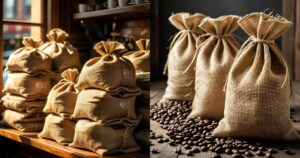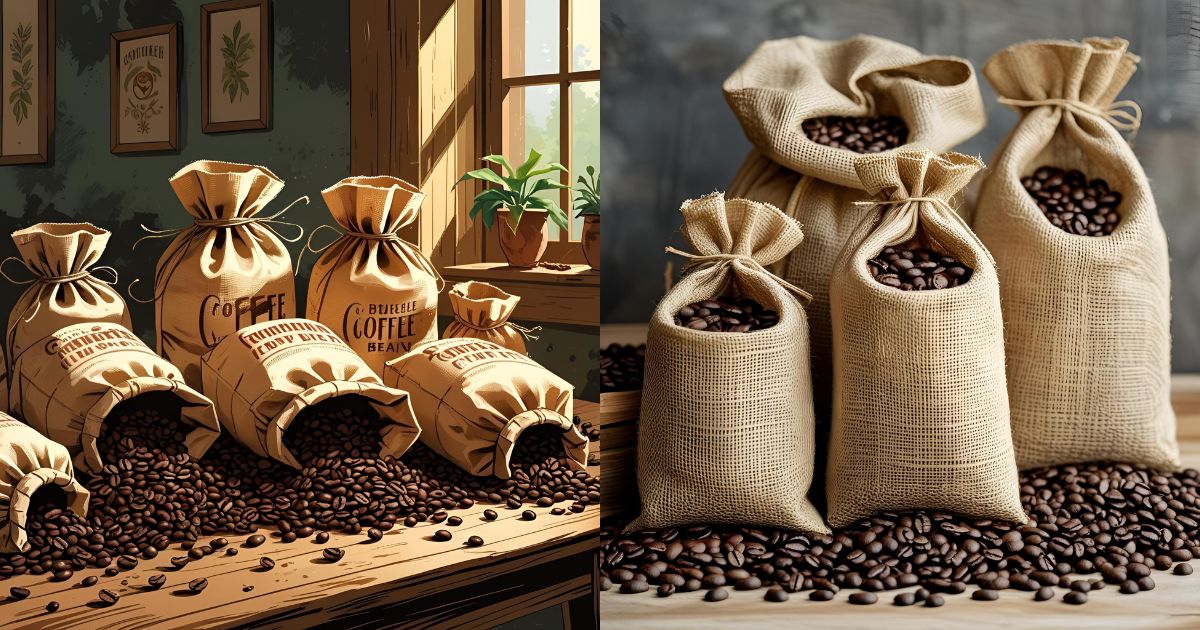Ever wondered what happens to those rugged, stamped sacks after they’ve hauled green coffee beans across continents?
Coffee bean bags burlap—also known as jute or hessian sacks—are more than just packaging. These breathable, biodegradable bags have been the backbone of global coffee transport for decades, often carrying 60 kg of raw beans each. They’re tough, eco-friendly, and stamped with beautiful origin marks that tell a story of where your coffee journey begins.
But here’s the twist: most of these bags get tossed after one use. That’s a missed opportunity.
Whether you’re a DIY enthusiast, a coffee lover looking to buy authentic sacks, or a sustainable shopper curious about repurposing, this guide is your one-stop resource.
Inside, I’ll discover how to choose quality burlap bags, where to get them (including free options), what to look for in size and material, and how to turn them into everything from garden tools to home décor.
I’ll also break down care tips, safety info, and real-world ideas from roasters and creatives alike.
Let’s dive in—and unlock the full potential of these iconic coffee carriers.
What Are Coffee Bean Burlap Bags?
Coffee bean burlap bags are large, breathable sacks made from natural fibers—most commonly jute or hessian fabric. Designed to transport unroasted (green) coffee beans across the globe, they’re durable, reusable, and environmentally friendly.
Materials & Construction
These bags aren’t just rustic—they’re functional by design.
Made from jute or hessian, plant-based fibers known for their strength and biodegradability.
Their woven texture allows air to pass through, keeping beans dry and reducing mold risk.
Coffee roasters and exporters often favor burlap for its low environmental impact and traditional appeal.
Unlike plastic, jute sacks decompose naturally, making them ideal for sustainable packaging.
User benefit: You get a strong, earth-friendly sack that’s both practical and reusable.
Standard Sizes & Capacity
Most burlap coffee bags follow international trade standards. Expect these typical specs:
60 kg capacity is the global standard (≈132 lbs).
Some variants hold 50 kg or less, often called gunny sacks.
Dimensions vary but often fall in the range of 28″ × 40″.
Sizes can differ based on origin (e.g., Ethiopian bags are often narrower than Colombian ones).
Pro tip: If you’re buying for decor or repurposing, check dimensions before purchasing.
Regional Markings & ICO Codes
What makes each burlap bag unique? The markings.
Bags are often stamped with country of origin, farm/exporter name, and lot number.
Many feature ICO codes (International Coffee Organization) to help trace beans back to source.
Logos, colorful graphics, and stencil prints make them popular for upcycled projects and rustic décor.
User tip: These details not only tell the story of your coffee—they also add character when repurposing.
Why Burlap Bags Are Used for Coffee

Burlap isn’t used by accident. It’s the result of decades of trial, error—and success.
Breathability & Moisture Control
Green coffee beans are sensitive to moisture. Burlap solves that.
The open weave of jute allows airflow, preventing condensation buildup.
This breathability helps avoid mold and mildew, especially during long shipping journeys.
Unlike plastic or vacuum sealers, burlap lets beans “breathe” while in transit or storage.
Your takeaway: Burlap ensures beans arrive fresh and mold-free.
Durability in Transit
These bags are built for global travel.
Can carry up to 150 lbs without tearing.
Reinforced seams hold up against stacking, tossing, and forklift movement.
Durable enough to be reused multiple times in the coffee supply chain.
End result: You’re investing in a bag that’s tough, time-tested, and worth repurposing.
Traditional & Sustainable Packaging
Coffee and burlap go way back.
Burlap has been the industry standard for over a century.
It’s biodegradable and renewable, aligning with global sustainability goals.
Many roasters prefer it over plastic or synthetic alternatives.
Eco-win: Burlap reduces packaging waste while honoring tradition.
Where to Buy Coffee Burlap Bags?
Looking to get your hands on authentic burlap coffee sacks? Whether you want them for décor, crafts, or gardening, knowing where (and how) to source them makes all the difference.
Let’s break it down.
New vs Used Bags
Used burlap coffee bags offer the most charm.
These bags often come stamped with country of origin, exporter details, and colorful graphics.
Great for crafts or rustic décor—every sack tells a story.
Buy from trusted sites like Sweet Maria’s, or ask your local coffee roaster—many give them away for free.
“I grabbed 5 bags from my neighborhood roaster last week—no charge.” (Reddit)
Brand-new burlap sacks are ideal for function over form.
No logos or markings—perfect if you’re using them in bulk or prefer a clean slate.
Available through wholesale coffee bag suppliers or general online retailers (Amazon, Etsy, burlap specialty sites).
👉 User tip: Choose used for visual appeal, new for consistency or food-safe needs.
Pricing & Bulk Options
Buying burlap bags doesn’t have to break the bank.
Used bags usually cost $2–$5 each.
Bulk packs (4–5 bags) go for $20–$30, depending on quality and markings.
Some suppliers offer discounts on 10+ bags, especially wholesale.
Want a better deal?
Bulk orders from online suppliers often come with free shipping.
Roaster giveaways? Free bags = 100% ROI.
Local Roasters or Free Sources
Here’s the secret most people miss: just ask.
Many coffee roasters receive burlap sacks weekly with green beans.
Once empty, the bags pile up—and many are happy to give them away.
Some even use them as marketing swag, event décor, or donation items.
How to get them:
Call or visit your neighborhood roaster.
Ask: “Do you have any extra burlap coffee sacks I could take?”
Check farmers markets, coffee expos, or local cafes partnered with roasters.
“Roasters always have extras. I walked out with 10 bags in one visit.” (Reddit)
Product Specs Comparison
Not all coffee burlap bags are created equal. Here’s how to spot the difference.
Dimensions & Weight Variants
Most bags fit within a standard size range:
28” × 40” – Common for Central American and African origins.
44” × 27” – Popular with Indonesian and Colombian shipments.
Designed to hold 60 kg (≈132 lbs) of green coffee beans.
Weight: empty bags typically weigh 1.5 to 2.5 lbs.
User tip: For upholstery or large crafts, look for bags on the larger end of the spectrum.
Graphics & Region Branding
Looking for authentic, rustic flair?
Many used coffee sacks feature hand-stamped or screen-printed logos, exporter names, or even artwork.
Stamps often show the country of origin, coffee grade, farm name, and crop year.
Bags from Ethiopia, Guatemala, or Colombia tend to have eye-catching designs.
These details make them perfect for wall art, throw pillows, or rustic retail displays.
Material Quality & Grades
Jute is the standard—but not all burlap is equal.
Jute vs. sisal: Jute is softer and more flexible, sisal is coarse but stronger.
Some bags are treated with mineral oils (especially food-grade versions).
Others may be untreated and rougher, great for crafts but not ideal for direct skin contact.
Quality markers to look for:
Tightly woven = longer-lasting.
Softer texture = easier for fabric projects.
No strong odor = better for indoor use.
Final tip: Always check product listings for condition, size, material, and markings—especially when buying online.
Read Also:
Creative Uses & Upcycling Ideas
Don’t toss your burlap coffee sacks—upcycle them into something beautiful, practical, or both.
These sturdy, rustic bags are ideal for gardening, sewing projects, and home décor. Let’s explore how to repurpose them like a pro.
Gardening & Landscaping
Burlap is a natural fit for outdoor use. It’s breathable, strong, and biodegradable.
Use them to:
Suppress weeds in garden beds as a natural barrier.
Provide frost protection for plants during colder months.
Line raised beds or planters to retain soil and moisture.
Wrap root balls during plant transport or transplanting.
Tip: Cut sacks to fit your garden layout and secure with garden staples.
Benefit: You save on landscaping fabric—and reduce waste at the same time.
Sewing & DIY Crafts
Burlap sacks are a favorite among crafters and upcyclers. Their printed designs and raw texture make them perfect for rustic projects.
Try making:
Throw pillow covers with origin-stamped panels.
Tote bags or gift bags with rope handles.
Lampshades, wine bottle covers, or utensil holders.
Seasonal wreaths and banners for farmhouse décor.
Start with a washed, softened sack for easier cutting and sewing.
Home Décor & Styling
Bring that authentic coffeehouse charm into your space.
Creative uses include:
Table runners or placemats for a rustic dining look.
Wall art made from stretched burlap on frames.
Rugs or doormats for an earthy, textured feel.
Curtains or window shades featuring bold logos or stamps.
Pro tip: Use spray adhesive or staple guns to mount burlap on canvas or wooden boards.
Benefit: Eco décor projects that cost less and mean more.
Care, Safety & Handling Tips
Before you repurpose your sacks, be sure they’re clean, safe, and prepped for use.
Odor & Residue Concerns
Used coffee sacks may carry:
A strong earthy or musty odor.
Loose fibers, dirt, or residual oils from the beans.
Occasional mold spots or staining.
Always inspect sacks before using them indoors or on skin-contact projects.
Washing & Pretreatment Advice
Cleaning burlap takes care. Here’s how:
Shake out dust and loose particles.
Hand wash with cold water and mild soap.
Air-dry flat—never machine dry (it warps the fibers).
Avoid bleach or harsh detergents.
Want a softer texture? Soak the fabric overnight in water with a splash of vinegar.
Food-Safe Usage Considerations
Burlap coffee bags are not guaranteed food-safe—especially reused ones.
Some are treated with mineral oil or other coatings to resist pests.
Staining or leftover coffee residue can make them unsuitable for direct food use.
Rule of thumb: Use new, untreated jute for anything involving food.
Conclusion
Coffee bean burlap bags offer far more than storage—they’re sustainable, versatile, and full of creative potential.
You’ve learned what they are, where to find them, how to repurpose them, and how to keep them clean and safe.
Now it’s your turn.
FAQ
What size is a coffee burlap bag?
Most bags measure 28″ × 40″, with some variations like 44″ × 27″, and typically hold 60 kg of beans.
Can you wash burlap coffee sacks?
Yes, but wash them by hand in cold water, then air-dry. Avoid bleach and machine drying.
Are burlap sacks food-safe or odor-free?
Not always. Used bags may contain oils or residue. Only use new, untreated sacks for food.
Where can I get origin-stamped, authentic coffee sacks?
Try Sweet Maria’s, local coffee roasters, or Etsy for stamped, used burlap coffee bags.

Mahian has an insatiable curiosity for discovering unique coffee beans and exploring global café trends. He delves into the stories of coffee origins, packaging innovations, and the evolving landscape of café culture. Mahian’s contributions provide readers with a broader perspective on the world of coffee.

